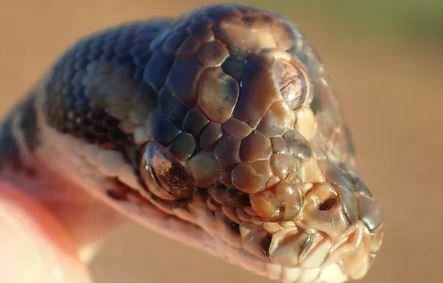Rangers in Australia could hardly believe their eyes when they came across a wild snake with three functioning peepers on its head.
The snake, a carpet python (Morelia spilota), had a third eye on its forehead. This condition is extremely rare, said David Penning, an assistant professor of biology at Missouri Southern State University, who was not involved with the snake’s case.
“Until today, I had not ever seen a snake with three eyes,” Penning told Live Science in an email. “I have seen snakes with two heads [and] some odd facial deformities but nothing quite like this.”
Rangers with Australia’s Northern Territory Parks and Wildlife Commission (NTPWC) found the wild triclops, whom they dubbed Monty, on a highway near Humpty Doo, a small town about 25 miles (40 kilometers) southeast of Darwin, in late March. (The snake died last week, at about 2 months old, according to news reports.)
The nonvenomous carpet python, which is native to Australia and New Guinea, can grow up to 9 feet (3 meters) long, but this snake was small — just about 16 inches (40 centimeters) long, indicating that it was a juvenile, the NTPWC said in a Facebook post.
Intrigued, the rangers had the snake X-rayed. The resulting images showed that the snake didn’t have two separate heads forged together, as the rangers had suspected. “Rather, it appeared to be one skull with an additional eye socket and three functioning eyes,” the NTPWC wrote in the post.
This deformity likely happened early on during the snake’s embryonic development, they said, adding that it was likely a “natural occurrence, as malformed reptiles are relatively common” and not due to environmental factors, such as pollution.
It’s impressive this snake even saw the light of day. Sometimes, mother snakes eat “bad” eggs called “slugs” after laying them, Penning said. Moreover, snakes born with deformities, such as spinal problems, typically die after a few days, he said.
Even more surprising is that the eye appeared to work. “Deformities rarely lead to normal operating functions,” Penning said. “When you think of the complexity involved within the skull and nervous tissue, there is so much more going on here than just that one new eye.” For instance, it’s likely that this third eye would need a third optic nerve, which would certainly complicate the brain’s typical layout, he said.
Might this third eye give the snake an evolutionary advantage? Even that’s hard to say, Penning said.
“Perhaps a third eye would allow for a wider visual field,” he said. “However, what is the developmental cost? Would it really do much to increase survival of those who have it?”
Penning said he has seen snakes survive with just one eye, “so perhaps two eyes are already overkill,” he noted. So, when it comes to having three eyes, “I would say it’s a disadvantage because it would cost more than the benefit of having it.”
This assessment jibed with reports from the rangers, who found that Monty struggled to eat because of his deformity, according to the Northern Territory News. This likely played a role in his demise. His remains are being stored at the Commonwealth Scientific and Industrial Research Organisation center in Darwin.
Monty wasn’t the only known animal with extra eyes. Genetically modified scarab beetles hatched in the lab sometimes grow a third eye, and fossil evidence indicates that a species of ancient monitor lizard that lived about 49 million years ago had four “eyes” — two normal eyes and two eye-like photosensory structures on top of its head.




